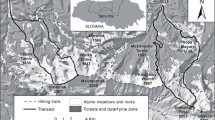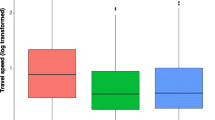Abstract
The mountain vizcacha (Lagidium viscacia) is a specialist of rocky habitats with colonies distributed along elevation gradients. Knowledge about its behavior is scarce and populations in northern Patagonia are declining. This is the first study describing the behavior and summer diurnal activity of two mountain vizcacha colonies under natural conditions. We registered by scan sampling the activities of 15 individuals during the period of 5 days. Vizcachas performed typical behaviors of rock specialists and allocated most of their time to foraging near the rock shelter (34%) and resting (26%). Behaviors such as locomotion (16%) and social interactions (10%) were important. Allogrooming (4.5%), vigilance (3%), and dust-bathing (1%) occupied a relatively small percentage of activities. In summer, the diurnal activity presented a bimodal distribution and was inversely related to the mean daytime air temperature, with a maximum peak between 8:00 and 9:00 h. Main activities such as foraging, resting, and locomotion were concentrated in the morning and at sunset. The behavioral responses suggest that the activity of this rodent in summer is influenced by thermal conditions. These results are a first important step in order to understand future vizcacha responses to climate change.



Similar content being viewed by others
References
Boyles J, Seebacher F, Smit B, McKechnie A (2011) Adaptive thermoregulation in endotherms may alter responses to climate change. Integr Comp Biol 51:676–690
Bozinovic F, Vásquez A (1999) Patch use in a diurnal rodent: handling and searching under thermoregulatory costs. Funct Ecol 13:602–610
Bozinovic F, Lagos JA, Vasquez RA, Kenagy GJ (2000) Time and energy use under thermoregulatory constraints in a diurnal rodent. J Therm Biol 25:251–256
Branch L (1993) Intergroup and intragroup spacing in the plain vizcacha, Lagostomus maximus. J Mammal 74:890–900
Bustos C (2006) Características climáticas del campo anexo Pilcaniyeu (Río Negro). Comunicación técnica Instituto Nacional de Tecnología Agropecuaria Centro Regional Patagonia Norte 25:1–6
Bustos C (2009) La temperatura media en Río Negro dentro de un marco de calentamiento global. Presencia 53:1–4
Cortés A, Rau JR, Miranda E, Jimémez JE (2002) Hábitos alimentarios de Lagidium viscacia y Abrocoma cinerea: dos roedores sintópicos en ambientes altoandino del norte de Chile. Rev Chil Hist Nat 75:583–593
Ebensperger LA (2000) Dustbathing and intra-sexual communication of social dues, Octodon degus (Rodentia: Octodontidae). Rev Chil Hist Nat 73:359–365
Galende GI (1998) El chinchillón patagónico. Rev Pat Silv 4:16–19
Galende GI (2010) Patrones de uso de recursos alimentarios y espaciales del chinchillón (Lagidium viscacia) y la liebre europea (Lepus europaeus) en roquedales del NO Patagónico. Dissertation Universidad Nacional de La Plata
Galende GI, Grigera D (1998) Relaciones alimentarias de Lagidium viscacia (Rodentia, Chinchillidae) con herbívoros introducidos en el Parque Nacional Nahuel Huapi, Argentina. Iheringia Sér Zool 84:3–10
Galende GI, Raffaele E (2008) Space use of a non-native species, the European hare (Lepus europaeus), in habitats of the southern vizcacha (Lagidium viscacia) in Northwestern Patagonia, Argentina. Eur J Wildl Res 54:299–304. https://doi.org/10.1007/s10344-007-0148-5
Galende GI, Raffaele E (2012) Diet selection of the southern vizcacha (Lagidium viscacia): a rock specialist in north western Patagonian steppe, Argentina. Acta Theriol 7:333–341. https://doi.org/10.1007/s13364-012-0078-9
Galende GI, Raffaele E (2013) Foraging behaviour and spatial use of a native rock-specialist the Southern vizcacha (Lagidium viscacia) and the exotic European hare (Lepus europaeus) in rocky outcrops of NW Patagonia, Argentina. Acta Theriol 58:305–313. https://doi.org/10.1007/s13364-012-0123-8
Galende GI, Raffaele E (2016) Predator feeding ecology on Patagonian rocky outcrops: implications for colonies of mountain vizcacha (Lagidium viscacia). Stud Neotropical Fauna Environ 51:104–111. https://doi.org/10.1080/01650521.2016.1185270
Galende GI, Úbeda C (1993) Aspectos del comportamiento individual y familiar del chinchillón Lagidium viscacia (chinchillidae). VIII JAM. SAREM San Carlos de Bariloche pp 52–53
Hoeck HN (1975) Differential feeding behaviour of the sympatric hyrax Procavia johnstoni and Heterohyrax brucei. Oecologia 22:15–47
Kenagy GJ, Vásquez RA, Nespolo RF, Bozinovic F (2002a) Daily and seasonal limits of time and temperature on surface activity of degus. Rev Chil Hist Nat 75:567–581
Kenagy GJ, Vásquez RA, Nespolo RF, Bozinovic F (2002b) A time-energy analysis of daytime surface activity in degus, Octodon degus. Rev Chil Hist Nat 75:149–156
Kenagy GJ, Vásquez R, Barnes BM, Bozinovic F (2004) Microstructure of summer activity bouts of degus in a thermally heterogeneous habitat. J Mammal 85:260–267
Kleiman D (1974) Patterns of behavior in hystricomorph rodents. J Zool:171–209
Lehner P (1979) Handbook of ethological methods, 1st edn. Garland STPM, New York
León RJ, Bran D, Collantes M, Paruelo JM, Soriano A (1998) Grandes unidades de vegetación de la Patagonia extra andina. Ecol Austral 8:125–144
Long R, Bowyer T, Porter W, Mathewson P, Monteith K, KIE J (2014) Behavior and nutritional condition buffer a large-bodied endotherm against direct and indirect effects of climate. Ecol Monogr 84:513–532
Mares MA, Lacher TE (1987) Ecological, morfological, and behavioral convergence in rock-dweling mammals. In: Hugh H, Genoways G (eds) Current mammalogy. Plenum Publishing Corporation, New York, pp 307–348
Mason T, Brivio F, Stephens PA, Apollonio M, Grignolio S (2017) The behavioral trade-off between thermoregulation and foraging in a heat-sensitive species. Behav Ecol 28:908–918. https://doi.org/10.1093/beheco/arx057
Mc Cain C, King B (2014) Body size and activity times mediate mammalian responses to climate change. Glob Chang Biol 20:1760–1769. https://doi.org/10.1111/gcb.12499
Milling C, Rachlow J, Johnson T, Forbey J, Shipley L (2017) Seasonal variation in behavioral thermoregulation and predator avoidance in a small mammal. Behav Ecol 28:1236–1247. https://doi.org/10.1093/beheco/arx084
Noy Meir I (1974) Desert ecosystems: higher trophic levels. Annu Rev Ecol Evol Syst 5:195–214
Nutt KJ (2007) Socioecology of rock-dwelling rodents. In: Wolf JO, Sherman PW (eds) Rodent societies: an ecological and evolutionary perspective. Chicago University Press, Chicago, pp 35–48
Parmesan C (2006) Ecological and evolutionary responses to recent climate change. Annu Rev Ecol Evol Syst 37:637–669
Pearson O (1948) Life of mountain Vizcachas in Perú. J Mammal 29:345–374
Puig S, Videla E, Cona M, Monge S, Roig V (1998) Diet of the mountain vizcacha (Lagidium viscacia Molina, 1782) and food availability in the northern Patagonia, Argentina. Mamm Biol 63:228–238
Puig S, Videla F, Cona MI, Monge SA (2007) Diet of the brown hare (Lepus europaeus) and food availability in northern Patagonia (Mendoza, Argentina). Mamm Biol 72:240–250
Reus Ruiz ML (2006) Caracterización del habitat y composición de la dieta de Lagidium viscacia (Chinchillidae), en la Puna-San Juan-Argentina. Dissertation Universidad Nacional de San Juan
Rowe R, Terry R, Rickart E (2011) Environmental change and declining resource availability for small-mammal communities in the Great Basin. Ecology 92:1366–1375
Smith A (1974) The distribution and dispersal of pikas: influences of behavior and climate. Ecol Lett 55:368–376
Speakman J, Król E (2010) Maximal heat dissipation capacity and hyperthermia risk: neglected key factors in the ecology of endotherms. J Anim Ecol 79:726–746
Terrien J, Perret M, Aujard F (2011) Behavioral thermoregulation in mammals: a review. Front Biosci 16(4):1428–1444. https://doi.org/10.2741/3797
Tirado C, Cortes A, Bozinovic F (2007) Metabolic rate, thermoregulation and water balance in Lagidium viscacia inhabiting the arid Andean plateau. J Therm Biol 32:220–226
Torres-Contreras H, Bozinovic F (1997) Food selection in an herbivorous rodent: balancing nutrition with thermoregulation. Ecol Lett 78:2230–2237
Verta G (2017) Patrones de actividad del chinchillón, chivo doméstico y carnívoros en dos sitios de Patagonia Norte. Dissertation, Universidad Nacional del Comahue
Walker SR (2001) Effects of landscape structure on the distribution of mountain vizcachas (Lagidium viscacia) in the Patagonian Steppe. Dissertation University of Florida
Walker SR, Ackerman G, Schachter-Broide J, Pancotto V, Novaro AJ (2000a) Habitat use by mountain vizcachas (Lagidium viscacia Molina, 1782) in the Patagonia steppe. Mamm Biol 65:293–300
Walker SR, Pancotto V, Schachter-Broide J, Ackerman G, Novaro AJ (2000b) Evaluation of a fecal-pellet index of abundance for mountain vizcachas (Lagidium viscacia). Mastozool Neotrop 7:89–94
Walker SR, Novaro AJ, Branch LC (2003) Effects of patch attributes, barriers, and distance between patches on the distribution of a rock-dwelling rodent (Lagidium viscacia). Landsc Ecol 18:187–194
Weir BJ (1971) Some notes on reproduction in the Patagonia Mountain viscachas Lagidium boxi (Mammalia; Rodentia). J Zool 164:463–467
Zar JH (1999) Biostatistical analysis, 6th edn. Prentice-Hall, Upper Saddle River
Acknowledgements
We thank Mauro Tamonne for help with fieldwork and Susan Walker and Silvina Ippi, and Emerson Viera for comments and improvements to the manuscript. We also thank the student field assistants.
Funding
This study was financially support provided by CONICET (PIP 5066) and the National University of Comahue (grant UNC-B126).
Author information
Authors and Affiliations
Corresponding author
Additional information
Communicated by: Emerson M. Vieira
Rights and permissions
About this article
Cite this article
Galende, G.I., Raffaele, E. Summer behavior and diurnal activity of mountain vizcachas (Lagidium viscacia) in two colonies of Northwestern Patagonia. Mamm Res 64, 271–278 (2019). https://doi.org/10.1007/s13364-018-0410-0
Received:
Accepted:
Published:
Issue Date:
DOI: https://doi.org/10.1007/s13364-018-0410-0




